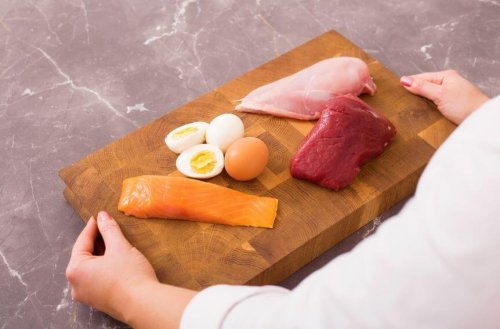Therapeutic Uses of a High-Protein Diet

High-protein diets are those that have a daily protein intake that’s greater than 0.04 ounces per 2.2 lbs of body weight. Someone with a high-protein diet can’t simply estimate their protein intake. They have to calculate it taking into account their weight and other factors. Let’s learn more about the therapeutic uses of a high-protein diet.
The World Health Organization recommends consuming 0.03 ounces of protein per 2.2 lbs of body weight per day for the general population. In the following article, we’ll explain the fundamentals of meal plans that provide higher intakes of protein.
What are the therapeutic uses of a high-protein diet?
Following a high-protein diet may or may not be for therapeutic reasons. Regardless, the nutritional targets of these diets are the following:
- Prevents tissue catabolism and weight loss. This implies stopping tissue loss when there’s an illness that requires a higher protein intake for this purpose, such as polytrauma.
- Facilitate tissue regeneration in subjects with burns or bedsores.
- Correct cases of malnutrition.
Indications for therapeutic uses of a high-protein diet
When setting your goals, it’s important to analyze the circumstances in which it’s appropriate to resort to a diet high in protein.
Diseases associated with metabolic stress
These situations occur in people with serious health concerns such as trauma, sepsis, surgical complications, or advanced stages of diseases such as cancer or AIDS.
In these circumstances, higher protein intakes are necessary because it produces a higher metabolic response. This means that the body needs more energy and protein than in normal conditions. This is in order to improve its functions and regenerate tissue as soon as possible.

Pathologies that produce tissue loss
People experiencing tissue loss are mainly those with extensive burns or bedsores. The latter is a very common problem for the bedridden geriatric population. As in the previous section, extra protein intake is essential in order to mitigate tissue loss.
Diseases that cause malabsorption
Some of the main causes of malabsorption in adults include bowel resection, chronic pancreatitis, or inflammatory bowel disease. In all of these cases, hypercaloric diets should be part of medical treatment.
Therapeutic uses of high-protein diets for athletes
Athletes have higher protein needs, especially those that perform intense workouts. During intense exercise, a catabolic state begins and some muscle fibers are broken. This is the reason why we have to carefully consider what to eat when in training or competition. This guarantees the proper synthesis of new proteins.
High-protein diets aren’t harmful when they’re taken in acceptable doses and in people who don’t use anabolics. In extreme situations, such as with bodybuilders, the protein intake can become exaggerated. This can lead to dehydration or the appearance of kidney stones and other problems.
Even though there’s no proven maximum protein intake limit, it’s known that too much protein can be bad. Intaking 0.14–0.18 ounces of protein per 2.2 lbs of weight per day can increase urea and creatinine levels.
A 2006 study concludes that a hyper protein diet of 0.18 ounces of protein per 2.2 lbs of weight a day can not only be harmful but also lead to diseases. However, a well-established and planned diet can be made with protein levels of up to 0.09 ounces of protein per 2.2lbs of weight per day.
How to cover protein needs?
The first thing to do is to set the amount of protein that you want to consume based on your total caloric intake. For example, if a 150-pound person starts out wanting 0.5 ounces of protein per 2.2 lbs of weight per day, then the diet would deliver 3.7 ounces of protein in total.

It’s important to increase your protein intake progressively. A good strategy can be to increase the number of daily intakes of protein by adding small protein-packed snacks throughout the day, such as homemade protein bars.
Another way to increase the content of this macronutrient in your diet is to enrich your main meal with protein powder. Meals such as stews or omelets take protein powder really well. A cheaper way of boosting protein intake in meals without having to use protein powder is adding add nuts or legumes to meals.
Finally, having a table of equivalences of protein rations on hand can help when you want flexibility and are facing trouble with following a specific pattern. Also, a solid nutritional education is essential for swapping out foods all the while respecting the guidelines of a quality diet and the periodicity of food.
High-protein diets are those that have a daily protein intake that’s greater than 0.04 ounces per 2.2 lbs of body weight. Someone with a high-protein diet can’t simply estimate their protein intake. They have to calculate it taking into account their weight and other factors. Let’s learn more about the therapeutic uses of a high-protein diet.
The World Health Organization recommends consuming 0.03 ounces of protein per 2.2 lbs of body weight per day for the general population. In the following article, we’ll explain the fundamentals of meal plans that provide higher intakes of protein.
What are the therapeutic uses of a high-protein diet?
Following a high-protein diet may or may not be for therapeutic reasons. Regardless, the nutritional targets of these diets are the following:
- Prevents tissue catabolism and weight loss. This implies stopping tissue loss when there’s an illness that requires a higher protein intake for this purpose, such as polytrauma.
- Facilitate tissue regeneration in subjects with burns or bedsores.
- Correct cases of malnutrition.
Indications for therapeutic uses of a high-protein diet
When setting your goals, it’s important to analyze the circumstances in which it’s appropriate to resort to a diet high in protein.
Diseases associated with metabolic stress
These situations occur in people with serious health concerns such as trauma, sepsis, surgical complications, or advanced stages of diseases such as cancer or AIDS.
In these circumstances, higher protein intakes are necessary because it produces a higher metabolic response. This means that the body needs more energy and protein than in normal conditions. This is in order to improve its functions and regenerate tissue as soon as possible.

Pathologies that produce tissue loss
People experiencing tissue loss are mainly those with extensive burns or bedsores. The latter is a very common problem for the bedridden geriatric population. As in the previous section, extra protein intake is essential in order to mitigate tissue loss.
Diseases that cause malabsorption
Some of the main causes of malabsorption in adults include bowel resection, chronic pancreatitis, or inflammatory bowel disease. In all of these cases, hypercaloric diets should be part of medical treatment.
Therapeutic uses of high-protein diets for athletes
Athletes have higher protein needs, especially those that perform intense workouts. During intense exercise, a catabolic state begins and some muscle fibers are broken. This is the reason why we have to carefully consider what to eat when in training or competition. This guarantees the proper synthesis of new proteins.
High-protein diets aren’t harmful when they’re taken in acceptable doses and in people who don’t use anabolics. In extreme situations, such as with bodybuilders, the protein intake can become exaggerated. This can lead to dehydration or the appearance of kidney stones and other problems.
Even though there’s no proven maximum protein intake limit, it’s known that too much protein can be bad. Intaking 0.14–0.18 ounces of protein per 2.2 lbs of weight per day can increase urea and creatinine levels.
A 2006 study concludes that a hyper protein diet of 0.18 ounces of protein per 2.2 lbs of weight a day can not only be harmful but also lead to diseases. However, a well-established and planned diet can be made with protein levels of up to 0.09 ounces of protein per 2.2lbs of weight per day.
How to cover protein needs?
The first thing to do is to set the amount of protein that you want to consume based on your total caloric intake. For example, if a 150-pound person starts out wanting 0.5 ounces of protein per 2.2 lbs of weight per day, then the diet would deliver 3.7 ounces of protein in total.

It’s important to increase your protein intake progressively. A good strategy can be to increase the number of daily intakes of protein by adding small protein-packed snacks throughout the day, such as homemade protein bars.
Another way to increase the content of this macronutrient in your diet is to enrich your main meal with protein powder. Meals such as stews or omelets take protein powder really well. A cheaper way of boosting protein intake in meals without having to use protein powder is adding add nuts or legumes to meals.
Finally, having a table of equivalences of protein rations on hand can help when you want flexibility and are facing trouble with following a specific pattern. Also, a solid nutritional education is essential for swapping out foods all the while respecting the guidelines of a quality diet and the periodicity of food.
All cited sources were thoroughly reviewed by our team to ensure their quality, reliability, currency, and validity. The bibliography of this article was considered reliable and of academic or scientific accuracy.
- Bilsborough S; Mann N. A Review of Issues of Dietary Protein Intake in Humans. International Journal of Sport Nutrition and Exercise Metabolism. 2016; 16(2), 129-152.
- Salas-Salvadó J; Sanjaume AB et al. Nutrición y dietética clínica. Elsevier Health Sciences. 2016.
This text is provided for informational purposes only and does not replace consultation with a professional. If in doubt, consult your specialist.








